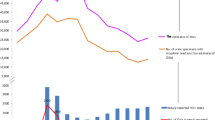Abstract
This study was undertaken to identify factors associated with entry into detoxification among injection drug users (IDUs), and to assess the role of needle-exchange programs (NEPs) as a bridge to treatment. IDUs undergoing semiannual human immunodeficiency virus (HIV) tests and interviews were studied prospectively between 1994 and 1998, during which time an NEP was introduced in Baltimore. Logistic regression was used to identify independent predictors of entry into detoxification, stratifying by HIV serostatus. Of 1,490 IDUs, similar proportions of HIV-infected and uninfected IDUs entered detoxification (25% vs. 23%, respectively). After accounting for recent drug use, hospital admission was associated with four-fold increased odds of entering detoxification for HIV-seronegative subjects. Among HIV-infected subjects, hospital admission, outpatient medical care, and having health insurance independently increased the odds of entering detoxification. After accounting for these and other variables, needle-exchange attendance also was associated independently with entering detoxification for both HIV-infected (adjusted odds ratio [AOR]=3.2) and uninfected IDUs (AOR=1.4). However, among HIV-infected subjects, the increased odds of detoxification associated with needle exchange diminished significantly over time, concomitant with statewide reductions in detoxification admissions. These findings indicate that health care providers and NEPs represent an important bridge to drug abuse treatment for HIV-infected and uninfected IDUs. Creating and sustaining these linkages may facilitate entry into drug abuse treatment and serve the important public health goal of increasing the number of drug users in treatment.
Similar content being viewed by others
References
Lurie P, Reingold A, Bower B, et al.The Public Health Impact of Needle Exchange Programs in the United States and Abroad. Vol 1. Atlanta, GA: Centers for Disease Control and Prevention; 1993.
Strathdee SA, van Ameijden E, Mesquita F, et al. Can HIV epidemics among injection drug users be prevented?AIDS. 1998;12(suppl A):S71-S79.
Normand J, Vlahov D, Moses LE.Preventing HIV Transmission: the Role of Sterile Needles and Bleach. Washington, DC: National Academy Press; 1995.
Hurley S, Jolley D, Kaldor J. Effectiveness of needle-exchange programmes for prevention of HIV infection.Lancet. 1997;349:1797–1800.
Paone D, Clark J, Shi Qiuhu, et al. Syringe exchange in the United States, 1996: a national profile.Am J Public Health. 1999:89(1):43–46.
Heimer R. Can syringe exchange serve as a conduit to substance abuse treatment?J Subst Abuse Treat. 1998;15(3):183–191.
Vlahov D, Junge B, Brookmeyer R, et al. Reductions in high-risk drug use behaviours among participants in the Baltimore needle exchange program.J Acquir Immune Defic Syndr Hum Retrovirol. 1997;16:400–406.
Heimer R, Kaplan EH, O'Keefe E, et al. Three years of needle exchange in New Haven: what have we learned?AIDS Public Policy J. 1994;9:59–74.
Brooner R, Kidorf M, King V, Beilenson P, Svikis D, Vlahov D.Drug abuse treatment success among needle exchange participants.Public Health Rep. 1998;113(suppl 1):129–139.
Metzger DS, Navaline H, Woody GE. Drug abuse treatment as AIDS prevention.Public Health Rep. 1998;113(1):97–105.
Centers for Disease Control and Prevention (US). Risk behaviors for HIV transmission among intravenous drug users not in treatment—United States.MMWR Morb Mortal Wkly Rep. 1990;39:273–276.
Schuster CR. Intravenous drug use and HIV prevention.Public Health Rep. 1988;103:261–263.
Vlahov D, Anthony JC, Munoz A, et al. The ALIVE Study: a longitudinal study of HIV-1 infection in intravenous drug users: description of methods.J Drug Issues. 1991; 21(4):759–776.
Anthony JC, Vlahov D, Nelson KE. New evidence on intravenous cocaine use and the risk of infection with human immunodeficiency virus type 1.Am J Epidemiol. 1991;134:1175–1189.
Zeger S, Liang KY. Longitudinal data analysis for discrete and continuous outcomes.Biometrics. 1986;42:121–130.
Department of Health and Human Service, Substance Abuse and Mental Health Services Administration (SAMHSA), Office of Applied Studies.National Admissions to Substance Abuse Treatment Services, the Treatment Episode Data Set (TEDS) 1992–1996. Rockville, MD: Office of Applied Science; 1997.
Alcohol and Drug Abuse Administration.Trends and Patterns in Maryland Alcohol and Drug Abuse Treatment 1997. Baltimore, MD: Maryland Department of Health and Mental Hygiene; 1998.
Heimer R, Khoshnood K, Bigg D, Guydish J, Junge B. Syringe use and re-use: effects of syringe exchange programs in four cities.J Acquir Immune Defic Syndr Hum Retrovirol. 1998;18(suppl 1):S37-S44.
Schechter MT, Strathdee SA, Cornelisse PGA, et al. Do needle exchange programs increase the spread of HIV among injection drug users: an investigation of the Vancouver outbreak.AIDS. 1999;13:F45-F51.
Substance Abuse and Mental Health Services Administration (SAMHSA), Office of Applied Science, Drug Abuse Network (DAWN) Series.D-3, Year-End Preliminary Estimates from the 1996 Drug Abuse Warning Network. Rockville, MD: Office of Applied Science; 1997.
CESAR.Herion Related Emergency Report Visits in Baltimore Metro Area Highest Among Cities in DAWN System. Baltimore, MD: Drug Awareness Warning Network; 1995. Advance Report Number 11.
Lewin VHI, Inc.An Analysis of Pilot Data on the Cost of Substance Abuse Treatment: Unit Costs From 77 Service Delivery Units. Technical Report to the Center for Substance Abuse Treatment. Fairfax, VA: National Evaluation Data and Technical Assistance Center (NEDTAC); 1996.
Shutz CG, Rapiti E, Vlahov D, et al. Suspected determinants of enrollment into detoxification and methadone maintenance treatment among injecting drug users.Drug Alcohol Depend. 1994;36:129–138.
Latkin C, Vlahov D, Anthony JC. Socially desirable responding and self-reported HIV infection risk behaviors among intravenous drug users.Addiction. 1993;88:517–526.
De Irala J, Bigelow C, McCusker J, et al. Reliability of self-reported human immunodeficiency virus risk behaviors in a residential drug treatment population.Am J Epidemiol. 1996;143:725–731.
Graeven DB, Graeven KA. Treated and untreated addicts: factors associated with participation in treatment and cessation of heroin use.J Drug Issues. 1983;83(2):207–218.
McCusker J, Bigelow C, Luippold R, et al. Outcomes of a 21-day drug detoxification program: retention, transfer to further treatment, and HIV risk reduction.Am J Drug Alcohol Abuse. 1995;21(1):1–16.
Author information
Authors and Affiliations
Corresponding author
Rights and permissions
About this article
Cite this article
Strathdee, S.A., Celentano, D.D., Shah, N. et al. Needle-exchange attendance and health care utilization promote entry into detoxification. J Urban Health 76, 448–460 (1999). https://doi.org/10.1007/BF02351502
Issue Date:
DOI: https://doi.org/10.1007/BF02351502




